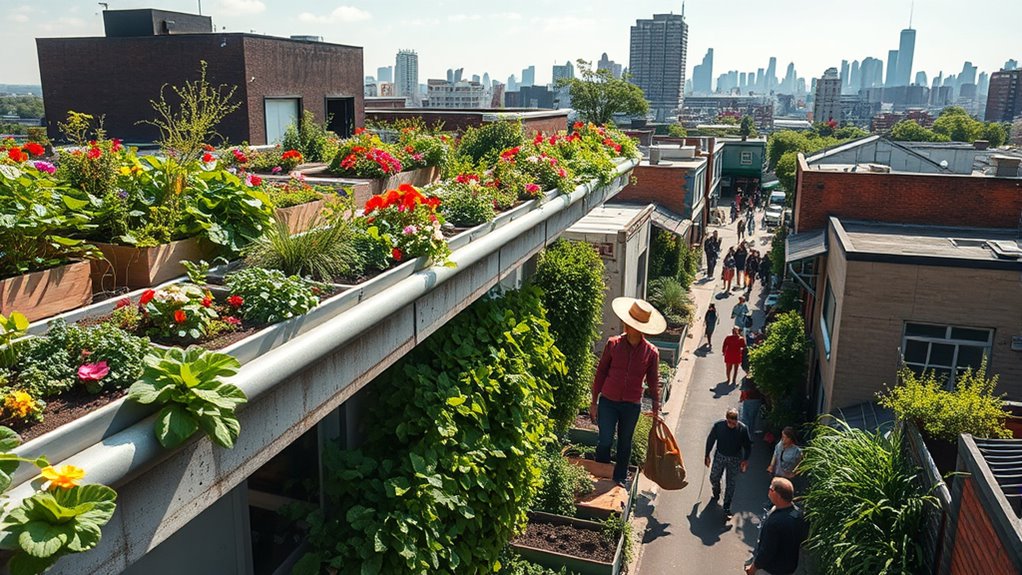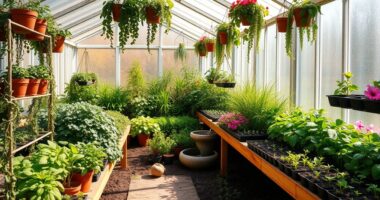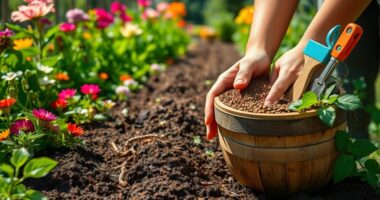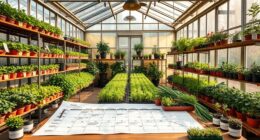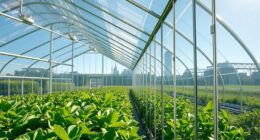Transforming your city into a green oasis starts with urban gardening techniques, like vertical gardening and hydroponics, which maximize limited spaces. I love the idea of rooftop gardens and community farms to boost local food production and enhance community ties. Prioritize soil quality, efficient water management, and crop selection strategies to guarantee success. Emphasizing sustainability not only beautifies the city but also encourages healthier eating. Stick around, and I'll share even more practices to help your city thrive!
Key Takeaways
- Implement vertical gardening techniques to maximize space in urban areas and promote food production on balconies and small plots.
- Establish community gardens to foster local food production, improve nutrition, and strengthen community ties through shared agricultural efforts.
- Utilize hydroponics and aquaponics systems for soil-less cultivation, enabling efficient food growth in limited spaces with minimal maintenance.
- Promote rooftop gardens to utilize underused spaces in buildings for urban agriculture, enhancing green infrastructure and biodiversity in cities.
- Encourage local governments to support urban agriculture initiatives by simplifying zoning laws and providing resources for sustainable farming practices.
The Urban Farmer: Growing Food for Profit on Leased and Borrowed Land
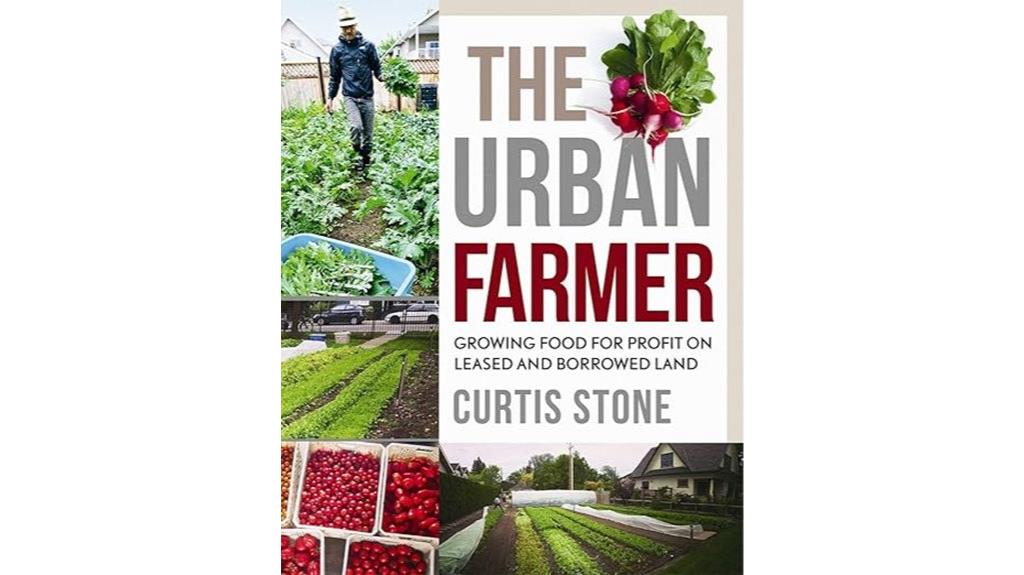
If you're someone who's enthusiastic to plunge into urban farming but feels overwhelmed by the logistics, "The Urban Farmer" by Curtis Stone is the perfect guide for you. This book breaks down the essentials of growing food for profit on leased and borrowed land. Stone provides practical steps on finding land, securing funding, and choosing the right crops. I love how he emphasizes efficiency, enabling high production in limited spaces. Plus, the adaptability of his methods means they work no matter where you are. Engaging with his online community further enhances the learning experience, making urban farming more accessible and achievable.
Best For: Aspiring urban farmers and individuals interested in sustainable food production who seek practical guidance in starting a farming business on leased or borrowed land.
Pros:
- Comprehensive Guidance: Offers detailed steps for negotiating land, securing funding, and selecting crops, making it a valuable resource for beginners.
- Efficiency Focus: Emphasizes high production in small spaces, allowing urban farmers to maximize yield without unnecessary labor.
- Adaptable Techniques: Core principles can be applied across various climates and locations, making it versatile for diverse farming environments.
Cons:
- Climate Limitations: Some sections may not apply to all climates, particularly those focused on extending the growing season in frost-free areas.
- Real-World Application: While it provides financial insights, actual profitability may vary based on local market conditions and personal execution.
- Supplemental Learning Required: Readers may need to explore additional resources for a broader understanding of sustainable practices beyond what's covered in the book.
Urban Gardening: The Art Of Growing Crops In Limited Spaces
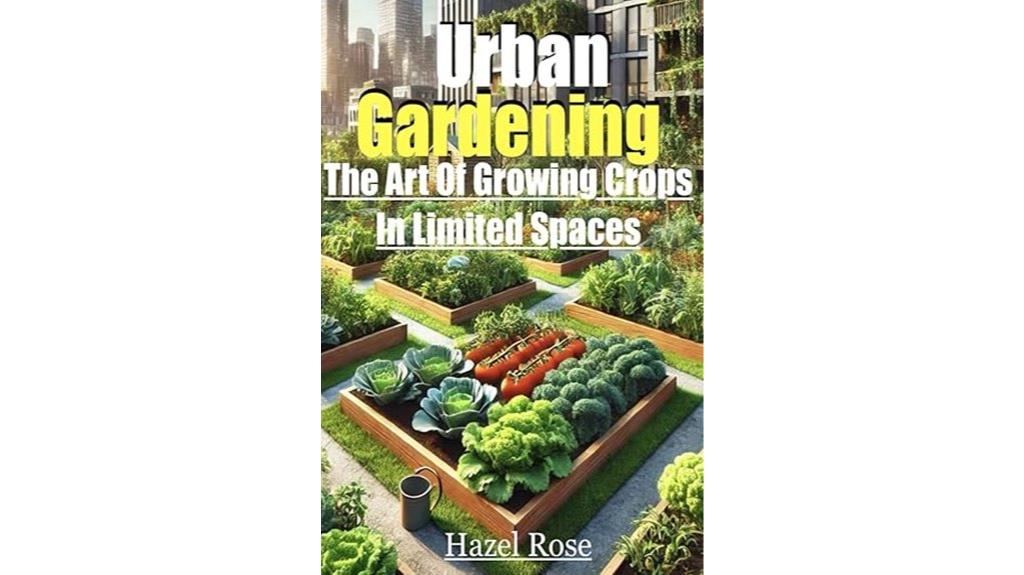
Urban gardening offers an exciting opportunity for city dwellers keen to cultivate their own green spaces, even in the tightest of quarters. I've discovered that techniques like vertical gardening and companion planting can transform small balconies into lush havens. Hydroponics and aquaponics also make it easy to grow food without traditional soil. While some resources may not dive deep into step-by-step methods, they provide a solid foundation for beginners. Indoor gardening captivates me too, allowing for the creation of serene spaces that connect us with nature. Embracing urban gardening not only beautifies our surroundings but also promotes sustainability in our cities.
Best For: Urban dwellers and gardening enthusiasts looking to cultivate crops in limited spaces while embracing sustainable practices.
Pros:
- Practical Techniques: Offers a variety of innovative methods like vertical gardening and hydroponics that are suitable for small spaces.
- Indoor Gardening Tips: Provides insights on creating indoor gardens, enhancing personal living spaces and connection with nature.
- Diverse Scenarios Covered: Addresses different gardening scenarios, making it accessible for both beginners and seasoned gardeners.
Cons:
- Limited Depth for Beginners: Some readers may find the lack of detailed step-by-step guidance challenging for novice gardeners.
- General Overview: The broad coverage of topics might not satisfy those seeking in-depth knowledge on specific techniques.
- Additional Resources Needed: Beginners may require supplementary materials for comprehensive understanding and execution of techniques.
Beginners Guide to Urban Hydroponic Gardening
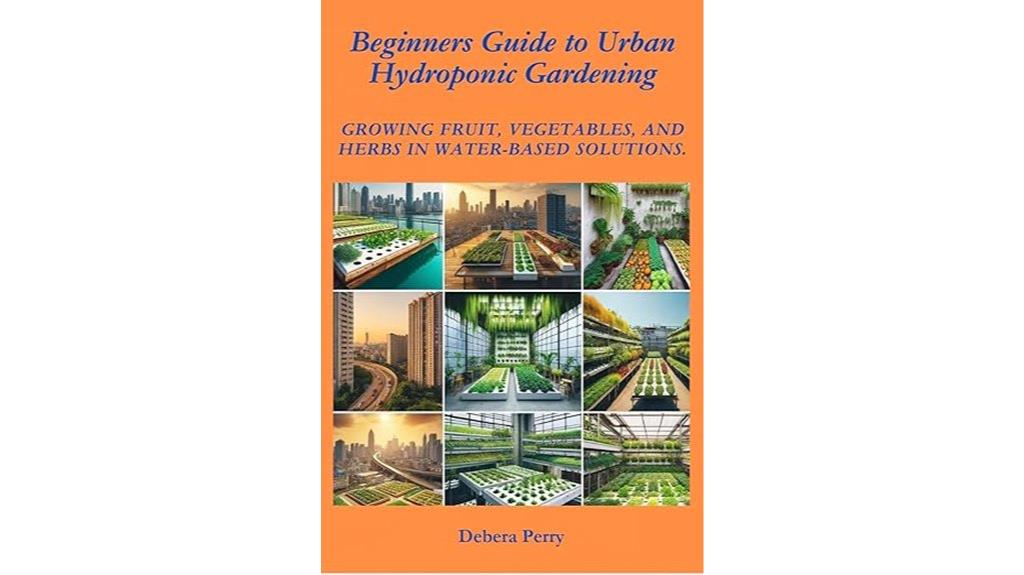
Looking to grow your own food but don't have much space? Hydroponics might be your perfect solution! I found the Beginners Guide to Urban Hydroponic Gardening incredibly helpful. It breaks down the process into simple steps, making it easy even for newbies like me. You can grow fresh fruits, vegetables, and herbs right from your kitchen or balcony. Plus, it requires low maintenance, so you don't need a green thumb. I've enjoyed harvesting strawberries and other plants, and I've gained a newfound enthusiasm for gardening. This guide is a must-read for anyone wanting to start their own urban garden!
Best For: Beginners looking to grow their own fruits, vegetables, and herbs in small urban spaces with minimal maintenance.
Pros:
- Simple, step-by-step guidance makes it easy for newcomers to follow.
- Ideal for small spaces like apartments or balconies, maximizing limited areas.
- Low maintenance requirements make it accessible for those without gardening experience.
Cons:
- Initial setup costs for hydroponic systems can be higher than traditional gardening.
- Limited plant variety compared to traditional soil gardening.
- Requires some knowledge of nutrient solutions and water management for optimal results.
Mini Farming: Self-Sufficiency on 1/4 Acre
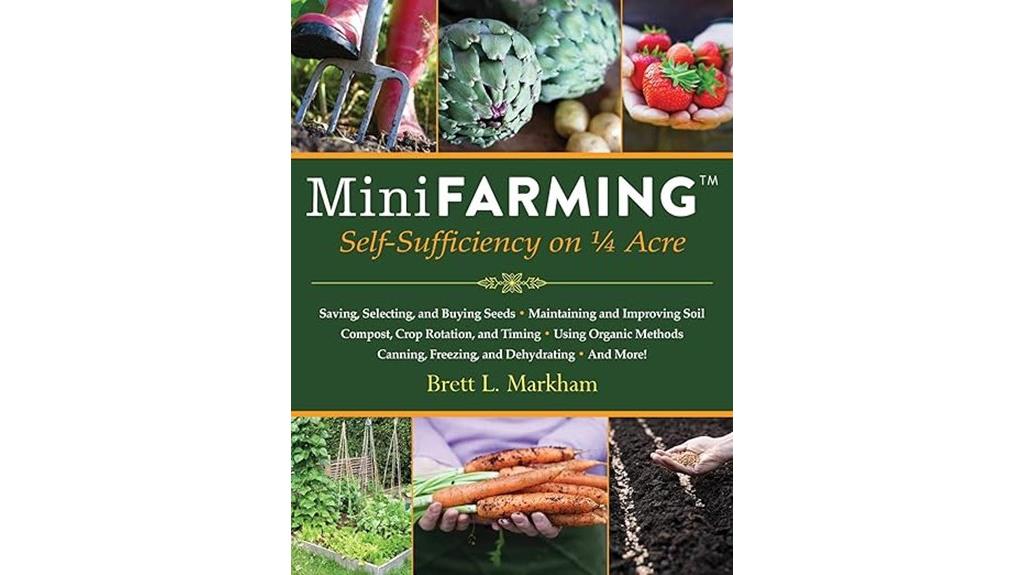
For anyone enthusiastic to embrace self-sufficiency in a manageable space, "Mini Farming: Self-Sufficiency on 1/4 Acre" stands out as an invaluable resource. This book simplifies intensive gardening, making it accessible, especially for urban dwellers. I appreciate the clear chapters on planning, composting, and irrigation systems, which build a solid foundation. It's tailored for beginners and offers practical tips without overwhelming detail. While some sections could use more depth, the engaging writing and helpful illustrations make it easy to follow. If you're looking to maximize a small plot for food production, this guide is a must-read!
Best For: Beginners and urban dwellers looking to cultivate self-sufficiency in small spaces.
Pros:
- Offers practical, easy-to-follow insights on intensive gardening techniques without overwhelming detail.
- Well-organized chapters provide a solid foundation on essential topics like planning, composting, and irrigation.
- Engaging writing and helpful illustrations enhance understanding for newcomers to gardening and farming.
Cons:
- Some chapters lack depth, leaving readers wanting more information, particularly in shorter growing seasons.
- Illustrated content might inflate the page count unnecessarily, with potential for more concise information.
- May not cover advanced topics in depth, which could limit more experienced gardeners' insights.
Food and the City: Urban Agriculture and the New Food Revolution
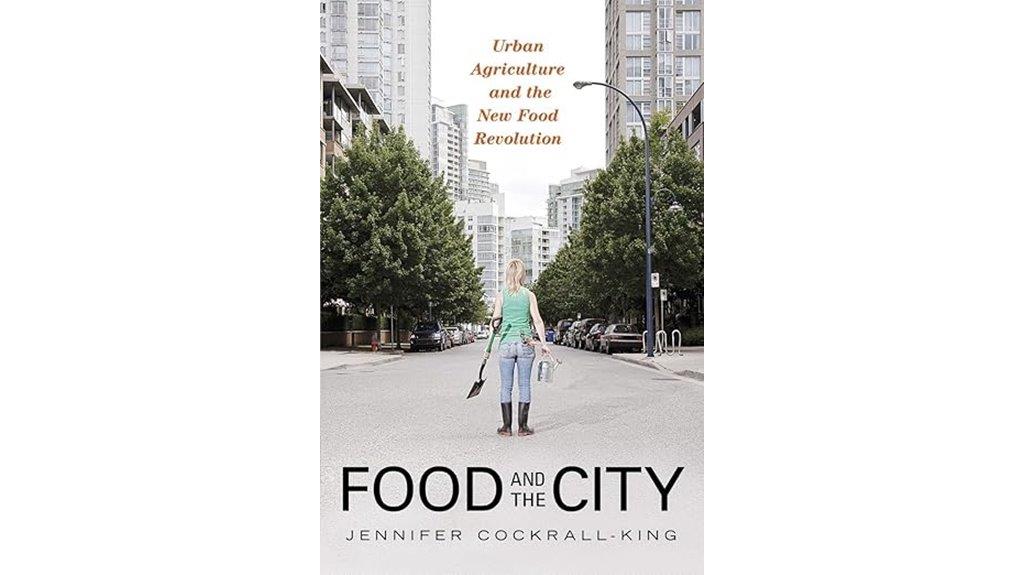
In cities where fresh produce is often hard to come by, "Food and the City" stands out as an essential resource for anyone enthusiastic to understand and engage in urban agriculture. Jennifer Cockrall-King passionately critiques our industrial food system, reminding us of the importance of knowing where our food comes from. She showcases inspiring initiatives like rooftop gardens and community farms that can transform our urban landscapes. By growing our food locally, we not only improve nutrition but also foster community ties. Let's embrace this food revolution and cultivate a greener, healthier future right in our backyards.
Best For: Individuals and communities seeking to enhance their understanding of urban agriculture and its benefits for nutrition and community building.
Pros:
- Promotes local food production, reducing dependence on industrial food systems and improving food security.
- Fosters community engagement through shared gardening initiatives, strengthening social ties among residents.
- Encourages healthier eating habits by providing access to fresh, home-grown produce.
Cons:
- May primarily benefit wealthier areas where urban farms cater to high-end restaurants, leaving underserved communities at a disadvantage.
- Sustainability concerns arise from reliance on low-rent or state-supported land for urban farming initiatives.
- Legal complexities surrounding guerrilla gardening can create challenges for urban agriculture efforts within a capitalist framework.
Urban Gardening: The Art Of Growing Crops In Limited Spaces
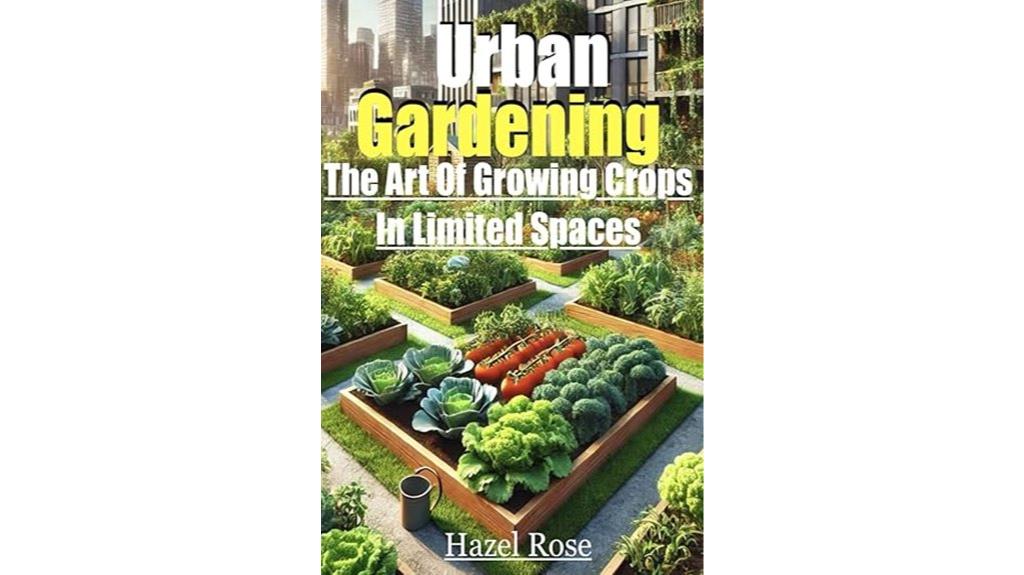
Urban gardening is perfect for anyone enthusiastic to transform limited spaces into thriving green oases. I've discovered that even a small balcony can become a lush sanctuary with the right techniques. Utilizing vertical gardening and companion planting not only maximizes space but also encourages natural pest control. For those busy like me, self-watering systems are a game changer. I love experimenting with indoor gardens too, bringing nature right into my home. Whether you're a seasoned gardener or just starting, urban gardening offers countless opportunities to create fresh, sustainable spaces that enhance our urban environments. Let's get growing!
Best For: Urban dwellers looking to maximize limited spaces for sustainable gardening and greenery.
Pros:
- Sustainable Practices: Encourages eco-friendly gardening techniques like companion planting and self-watering systems.
- Diverse Techniques: Covers a wide range of methods, including vertical gardening, hydroponics, and aquaponics, suitable for any skill level.
- Indoor Gardening Appeal: Inspires readers to create indoor gardens, enhancing their living spaces and connection to nature.
Cons:
- Limited Depth for Beginners: Some readers may find the guidance lacking in detailed, step-by-step instructions for novices.
- Broad Overview: The book provides a general introduction without diving deeply into specific topics, which may require additional resources for comprehensive understanding.
- Accessibility of Advanced Techniques: While it introduces advanced methods, beginners might feel overwhelmed by hydroponics and aquaponics without thorough explanations.
Designing Urban Agriculture: A Complete Guide to Edible Landscapes
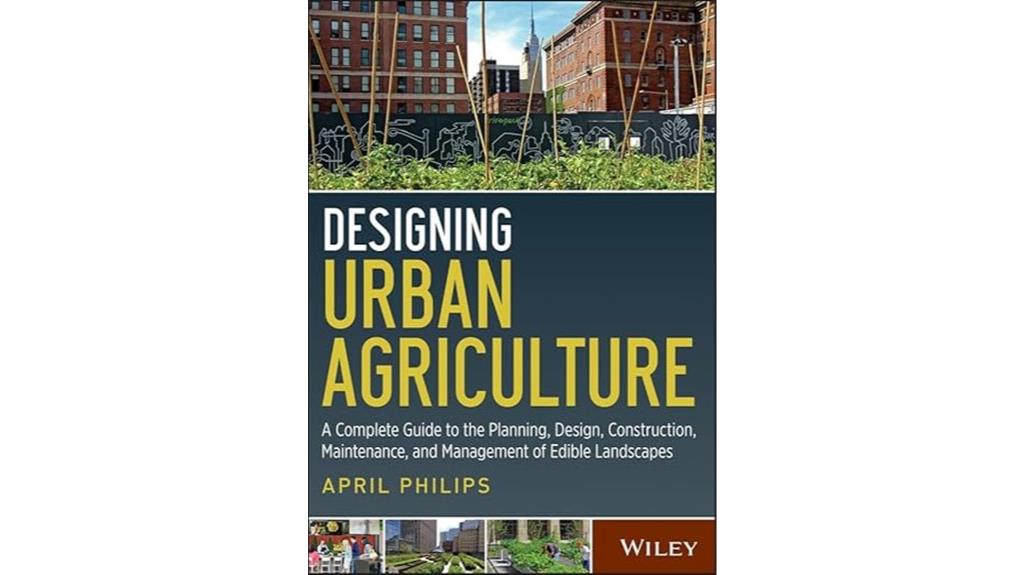
Designers, educators, and community planners will find "Urban Agriculture Practices" to be an invaluable resource in creating sustainable edible landscapes. This guide dives into the planning, design, and management of urban agriculture, emphasizing the connections between projects and the communities they serve. While it caters to larger projects like schools and parks, it may miss the mark for suburban homeowners. I appreciate the inspiring case studies and practical methodologies, making it a solid reference. However, some readers might find the content a bit scattered. Overall, it's a useful tool for anyone passionate about transforming urban spaces into green oases.
Best For: Designers, educators, and community planners interested in creating sustainable urban agricultural projects for larger spaces like schools and parks.
Pros:
- Well-researched with inspiring case studies and full-color photographs.
- Offers practical methodologies and insights for project planning and management.
- Engaging content that serves as both an introductory text and a reference guide.
Cons:
- May not cater to suburban homeowners or those seeking smaller-scale urban agriculture solutions.
- Some content can feel scattered or tangential, straying from the main topics.
- Occasional moralistic tones may not resonate with all readers.
Urban Farming, 2nd Edition: Comprehensive Guide to Urban Agriculture
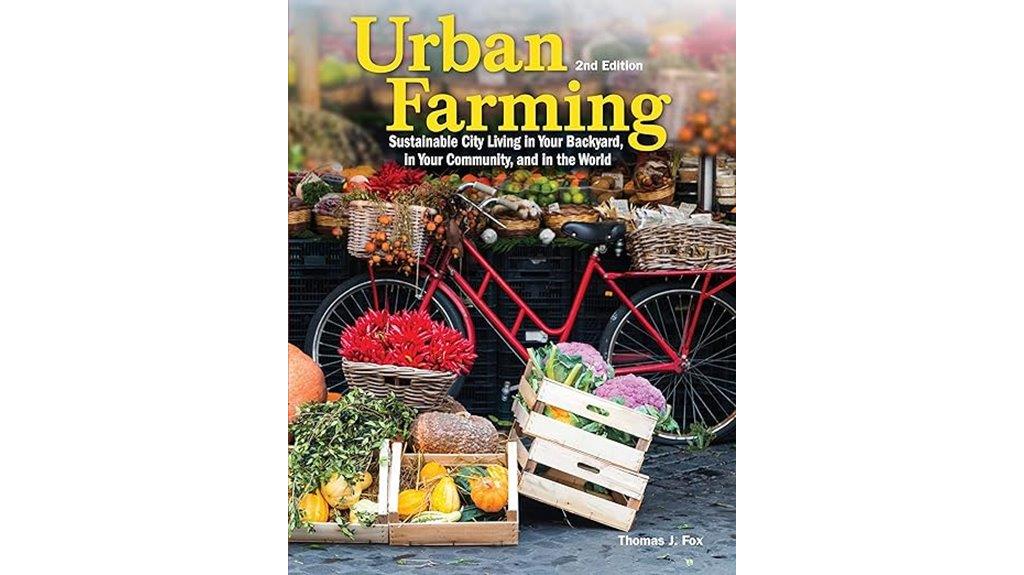
For anyone enthusiastic to embrace sustainable living in an urban setting, "Urban Farming, 2nd Edition: Extensive Guide to Urban Agriculture" stands out as an essential resource. Despite arriving with some bent pages, the book's overall quality remains good. Its stunning illustrations and photos inspire me to envision my urban farming potential. I've found the well-written content incredibly useful, providing clear insights into achieving self-sufficiency in city life. This guide truly makes me excited to begin my urban farming journey and transforms my backyard into a green oasis. It's a must-have for anyone committed to sustainable living!
Best For: Individuals interested in sustainable living and urban agriculture seeking self-sufficiency in urban environments.
Pros:
- Beautiful illustrations and photos that inspire urban farming ideas.
- Well-written content providing clear and effective insights.
- Comprehensive guide suitable for beginners and experienced urban farmers alike.
Cons:
- Arrived with some bent pages, affecting initial presentation.
- Not in brand new condition, which may be a concern for gift-giving.
- Some may find the content too general if seeking advanced techniques.
Urban Survival Guide for City Dwellers
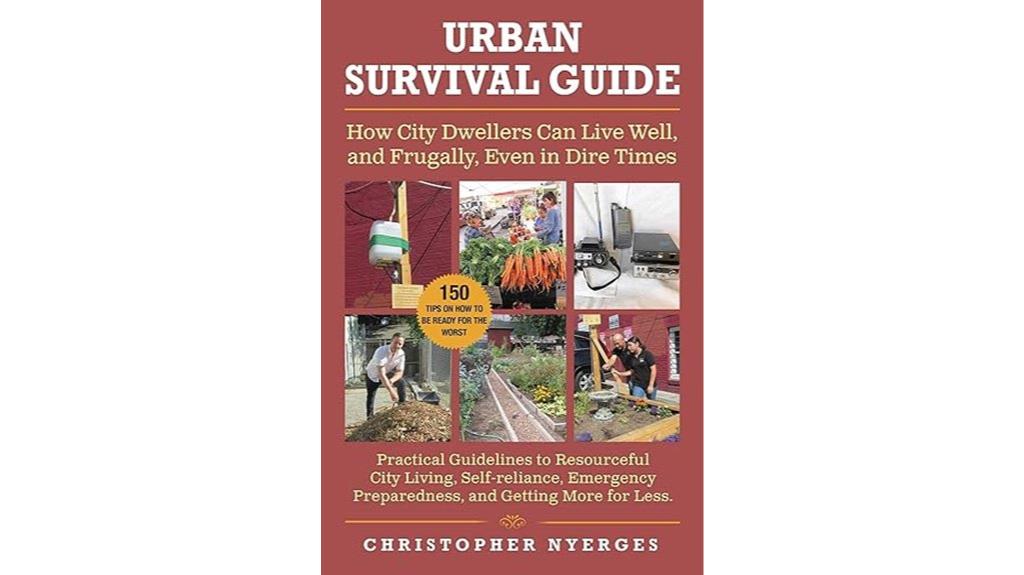
City dwellers seeking to enhance their self-reliance will find the "Urban Survival Guide" by Christopher Nyerges to be an invaluable resource. This book combines practical survival methods with everyday solutions, making it accessible for all. You'll learn how to create food sources, purify water, and perform basic first aid. Nyerges emphasizes fun and resourcefulness, ensuring urban living isn't just about survival but enjoyment too. Priced under $20, it's a worthwhile investment that pays off quickly. Readers rave about its unique approach, making it an essential handbook for thriving in any city environment while being prepared for emergencies.
Best For: Urban dwellers looking to enhance their self-reliance and practical survival skills in a city environment.
Pros:
- Practical advice: Offers realistic and affordable survival methods suitable for everyday life.
- Wide-ranging skills: Covers essential topics like food sourcing, water purification, and basic first aid.
- Enjoyment focus: Encourages resourcefulness and fun, making urban living more enjoyable.
Cons:
- Limited to urban settings: Some techniques may not be applicable in rural or wilderness environments.
- Basic information: More experienced survivalists might find some content too elementary.
- Indie publication: The quality might not match that of high-end commercial releases for some readers.
Carrot City: Creating Places for Urban Agriculture
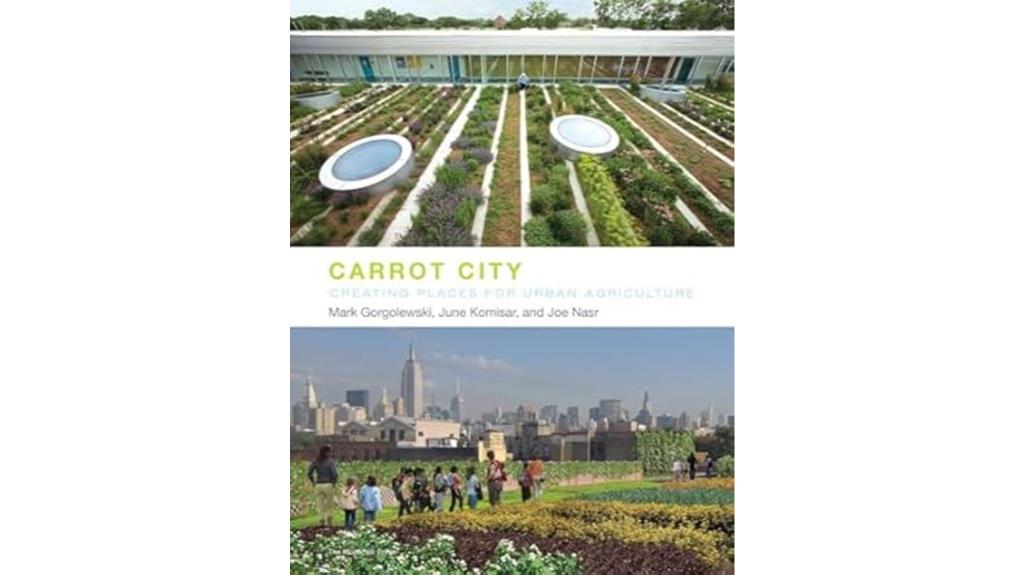
If you're passionate about merging urban planning with sustainable food production, "Carrot City: Creating Places for Urban Agriculture" is an essential read. This beautifully formatted book is a treasure trove of innovative concepts, showcasing how urban agriculture can intertwine with design and green infrastructure. I love its vibrant project images that make the content not just informative but visually appealing. Friends and graduate students I've shared it with have found it incredibly relevant for both academic and personal use. Inspired by discussions from the Urban Agriculture Summit in Toronto, this book pushes boundaries and sparks creative ideas for transforming our cities into green oases.
Best For: Urban planners, students, and enthusiasts of sustainable food systems looking for innovative ideas in urban agriculture.
Pros:
- Visually appealing: The book is filled with vibrant project images that enhance the reading experience.
- Informative resource: It serves as a valuable reference for research projects and idea generation in urban agriculture.
- Inspires collaboration: Encourages the integration of urban agriculture with design, planning, and green infrastructure.
Cons:
- Geographic focus: Primarily showcases examples from North America, which may limit its applicability to other regions.
- Niche subject: May not appeal to readers without a specific interest in urban agriculture or sustainable design.
- Limited depth: Some readers may find that certain topics could be explored in greater detail.
Factors to Consider When Choosing Urban Agriculture
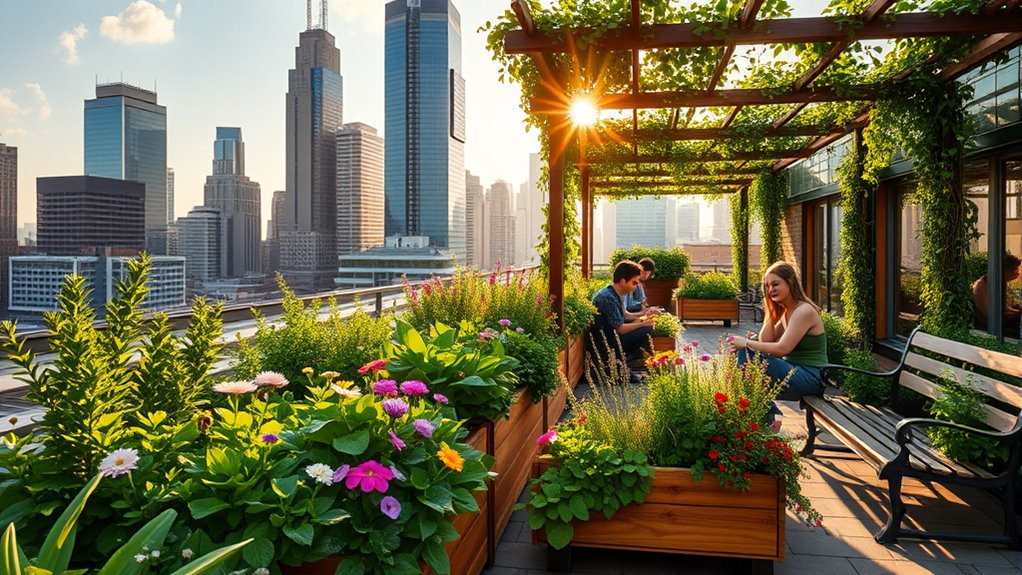
When I think about starting an urban agriculture project, I realize several key factors come into play. Available space, local climate, and soil quality all shape what I can grow successfully. Plus, I need to take into account water access and choose crops that fit my specific conditions.
Available Space Constraints
Urban agriculture presents unique opportunities and challenges, especially concerning available space constraints. I've learned that evaluating our options, from small balconies to larger community gardens, is vital. We need to make efficient use of these limited areas. Vertical gardening techniques have been a game changer for me, allowing crops to grow upwards instead of spreading out. Using containers, raised beds, and hydroponic systems also helps maximize space while offering flexibility in urban settings. However, I can't overlook soil quality and sunlight exposure—limited space can restrict access to these essentials, so I must plan strategically. Engaging with the community to utilize shared spaces like vacant lots or rooftops can further expand our agricultural possibilities, fostering collaboration among neighbors.
Local Climate Conditions
Maximizing available space is just one part of the urban agriculture equation; local climate conditions play a significant role in determining what can thrive in these environments. I've learned that temperature ranges, precipitation levels, and seasonal changes greatly influence our crop choices. Understanding the frost-free days in my area is vital for planning planting and harvesting schedules, especially since some crops need longer growing seasons. I also pay attention to microclimates—like warmer spots near buildings or cooler shaded areas—as they can affect plant health. By using local climate data, I can time my sowing and transplanting to optimize yields while minimizing risks from extreme weather. Adapting practices, such as irrigation and selecting heat-resistant crops, guarantees success.
Soil Quality Assessment
Soil quality is the backbone of successful urban agriculture, and evaluating it properly can make all the difference in my gardening endeavors. I start by testing the pH levels, aiming for a range between 6.0 and 7.5, which is ideal for most vegetables. This assessment helps me identify any nutrient deficiencies or toxicities, particularly for nitrogen, phosphorus, and potassium, essential for robust plant growth. I also pay attention to organic matter content, ensuring it's at least 5% for best soil structure and water retention. Finally, I check for potential contamination from heavy metals or chemicals common in urban areas, ensuring the safety of the food I grow. Taking these steps sets a solid foundation for my urban garden's success.
Water Access and Management
When contemplating urban agriculture, one of the first things I think about is water access, since it's vital for plant health and productivity. Inadequate water supply can lead to reduced yields or even crop failure, which no one wants. I've found that efficient water management techniques like drip irrigation and rainwater harvesting greatly lower water usage while promoting sustainability. However, I also need to take into account water quality; testing and possibly treating the water guarantees it's safe for irrigation. Implementing self-watering systems can simplify my watering routine, especially in limited spaces. Finally, understanding local water regulations is essential because they can affect my access to water sources and how I manage irrigation in my urban garden.
Crop Selection Strategies
Choosing the right crops for urban agriculture can greatly influence the success of my garden, especially when I consider factors like space and climate. I prioritize high-yield, space-efficient crops like leafy greens and herbs, which thrive in limited areas. Evaluating my local climate helps me select the best varieties; for instance, I choose heat-tolerant crops in warmer regions and frost-resistant ones in cooler climates. Implementing companion planting strategies boosts productivity and pest management, creating a resilient ecosystem. I also focus on crops with shorter growth cycles, like radishes and lettuce, to maximize turnover and allow for multiple harvests. Finally, I evaluate market demand, opting for high-value produce that can sell well at farmers' markets or to local restaurants.
Community Engagement Opportunities
In urban agriculture, engaging the community can make a real difference in the success of projects. By creating initiatives like community gardens and urban farms, we foster social connections and enhance the sense of belonging among residents. These platforms empower locals to learn about sustainable practices, healthy eating, and food production, encouraging them to take an active role in their food systems.
When we involve community members, we can raise awareness about food insecurity and motivate collective action to improve food access. Participation allows us to share knowledge and resources, creating a culture of cooperation that benefits everyone. Plus, collaborative projects can serve as educational tools, offering workshops that teach valuable skills related to gardening, nutrition, and environmental stewardship.
Financial Investment Requirements
While maneuvering through the financial landscape of urban agriculture, I find it essential to reflect on several key factors that can impact the success of my venture. First, I need to assess the costs of land leasing, soil amendments, seeds, and infrastructure like greenhouses or irrigation systems. Initial investments can range from a few hundred to several thousand dollars, depending on my operation's size and complexity. I also have to take into account ongoing operational costs, including labor and utilities, to guarantee long-term profitability. Securing funding is vital, so I'll explore grants, crowdfunding, or loans, and check if my project qualifies for subsidies. Finally, I must evaluate profitability through crop yields, market prices, and sales strategies to determine financial viability.
Sustainability and Environmental Impact
Understanding sustainability and environmental impact is crucial when I consider urban agriculture. By growing food locally, I can greatly reduce carbon footprints since less transportation means lower emissions. I also find that implementing practices like organic farming and permaculture enhances soil health and promotes biodiversity, while minimizing harmful chemical runoff.
Urban agriculture can transform our city into a greener space, improving air quality and regulating temperatures in densely populated areas. I'm excited about using rainwater harvesting and graywater recycling, which makes water use more efficient and conserves precious resources. Plus, integrating urban farming into city planning can restore habitats for pollinators and wildlife, fostering a healthier urban ecosystem. Embracing these practices can truly make a difference.
Frequently Asked Questions
How Can Urban Agriculture Improve Local Air Quality?
Urban agriculture can really enhance local air quality, and I've seen it firsthand. By growing plants in our neighborhoods, we're not just producing food; we're also increasing greenery that absorbs carbon dioxide and releases oxygen. This helps filter pollutants and provides a natural barrier against dust and other airborne particles. I've noticed that the more green spaces we create, the fresher and cleaner the air feels, benefitting everyone in the community.
What Are the Economic Benefits of Urban Farming for Cities?
Urban farming's economic benefits are significant. I've seen how it boosts local economies by creating jobs and increasing food access. It also reduces transportation costs, keeping money in the community. Plus, urban farms can attract tourism and increase property values. When I walk through a city with vibrant gardens, I feel the energy and potential it brings, not just for food but for stimulating local businesses and fostering community pride.
How Does Urban Agriculture Impact Community Social Dynamics?
Did you know that urban agriculture can boost community interaction by up to 25%? I've seen firsthand how these green spaces bring people together. Neighbors share gardening tips, exchange produce, and collaborate on projects. It's amazing how a simple garden can create a sense of belonging and pride. When we cultivate food together, we're not just growing plants; we're nurturing relationships, fostering a supportive community, and enhancing our social fabric.
What Policies Support Urban Agriculture Initiatives in Cities?
When I think about policies supporting urban agriculture, I see a variety of approaches cities can adopt. Zoning reforms can make it easier to use land for farming, while grants and subsidies help individuals start projects. Community-supported agriculture programs also create connections between local farmers and consumers. I've noticed that educational initiatives can raise awareness and promote participation, fostering a culture of sustainability and cooperation in our neighborhoods. These policies really make a difference!
How Can Schools Incorporate Urban Agriculture Into Their Curriculum?
Have you ever thought about how schools can nurture a love for nature? I believe incorporating urban agriculture into the curriculum is a fantastic way to engage students. By creating school gardens, we can teach kids about sustainability, nutrition, and responsibility. Hands-on activities, like planting and harvesting, make learning fun and practical. Plus, it fosters teamwork and community spirit. Let's inspire the next generation to appreciate where their food comes from!
Conclusion
In embracing urban agriculture, we can create vibrant community gardens, lush rooftop farms, and thriving green spaces. We can transform concrete jungles into flourishing oases, where fresh food flourishes and connections grow. By cultivating our land, we cultivate our spirit; by nurturing our plants, we nurture our community. So let's dig in, sow the seeds of change, and watch our cities bloom with life, color, and flavor. Together, we can turn our urban landscapes into a paradise of possibility.
